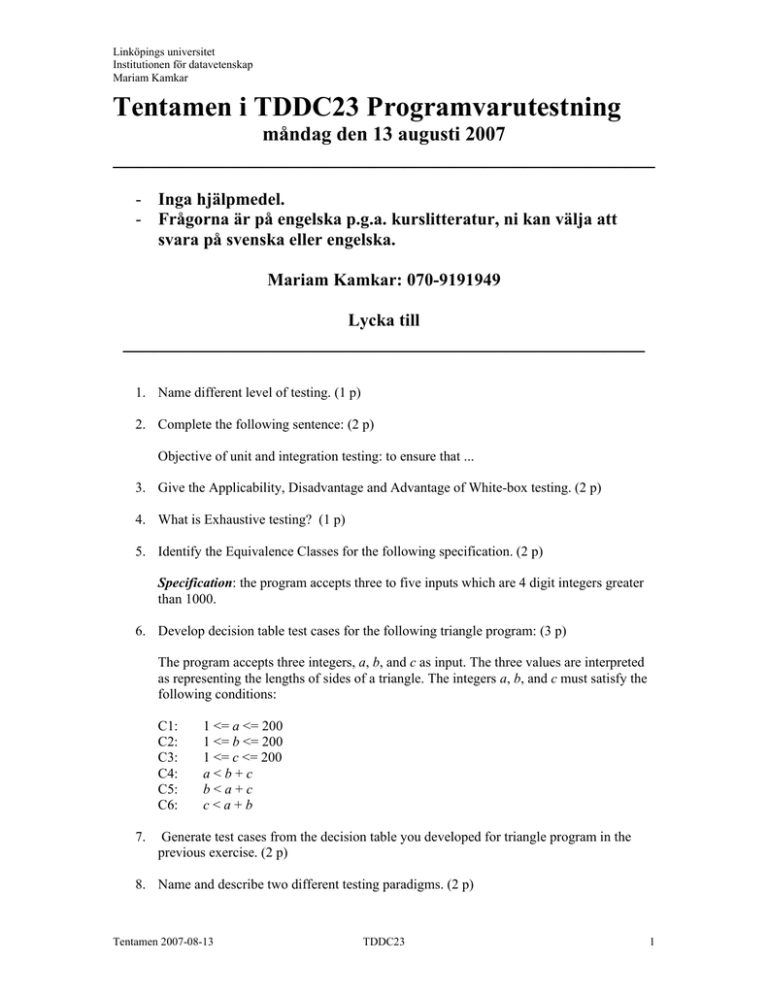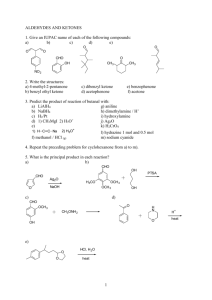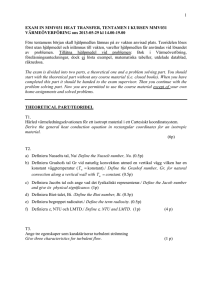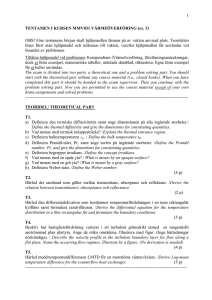Tentamen i TDDC23 Programvarutestning
advertisement

Linköpings universitet Institutionen för datavetenskap Mariam Kamkar Tentamen i TDDC23 Programvarutestning måndag den 13 augusti 2007 ______________________________________________________ - Inga hjälpmedel. - Frågorna är på engelska p.g.a. kurslitteratur, ni kan välja att svara på svenska eller engelska. Mariam Kamkar: 070-9191949 Lycka till ____________________________________________________ 1. Name different level of testing. (1 p) 2. Complete the following sentence: (2 p) Objective of unit and integration testing: to ensure that ... 3. Give the Applicability, Disadvantage and Advantage of White-box testing. (2 p) 4. What is Exhaustive testing? (1 p) 5. Identify the Equivalence Classes for the following specification. (2 p) Specification: the program accepts three to five inputs which are 4 digit integers greater than 1000. 6. Develop decision table test cases for the following triangle program: (3 p) The program accepts three integers, a, b, and c as input. The three values are interpreted as representing the lengths of sides of a triangle. The integers a, b, and c must satisfy the following conditions: C1: C2: C3: C4: C5: C6: 7. 1 <= a <= 200 1 <= b <= 200 1 <= c <= 200 a<b+c b<a+c c<a+b Generate test cases from the decision table you developed for triangle program in the previous exercise. (2 p) 8. Name and describe two different testing paradigms. (2 p) Tentamen 2007-08-13 TDDC23 1 Linköpings universitet Institutionen för datavetenskap Mariam Kamkar 9. The following figure illustrates the component hierarchy in a software system. Describe the sequence of tests for integration the components using a bottom-up approach and a sandwich approach. (4 p) A B F C G D H L I M J E K N 10. Find the source and sink nodes in the following graph with MM-path, module A calls module B, which in turn calls module C. (3 P) A C B 1 1 1 2 2 2 3 4 3 3 4 4 5 5 6 11. Based on source and sink nodes find the module execution paths (MEP) in the graph. (4p) MEP (A, I) = MEP (A, II) = MEP (A, III) = MEP (B, I) = MEP (B, II) = MEP (C, I) = MEP (C, II) = 12. Describe test stubs and drivers. When are they needed, and why? ( 2 p) 13. Specification: the character in column 1 must be an “N” or a “P”. The character in column 2 must be a digit. In this situation, the file update is made. If the first character is incorrect, message M-1 is issued. If the second character is not a digit, message M-2 is issued. Tentamen 2007-08-13 TDDC23 2 Linköpings universitet Institutionen för datavetenskap Mariam Kamkar Based on this specification: ( 5 p) - Identify causes and effects - Design a cause-effect graph with constraint from identified causes and effects - Propose a decision table for testing the software 14. Explain the three following Scripting techniques. (3 p) - Linear - Structured - Keyword-driven 15. Early data flow analysis often centered on a set of faults that are known as define/reference anomalies. Given the following notations and the control flow graph annotated with define-use-kill information, for each variable examine the define-use-kill patterns along the control flow graph and the kind of anomaly it could generate. (3 p) • • • • • • d: defined, created, initialized, etc. k: killed, undefined, released u: used for something ~d: the variable does not exist, then it is defined ~u: the variable does not exist, then it is used ~k: the variable does not exist, then it is killed define x use y kill z kill z use x define z define x use x use z define y use z use y use z kill y define z 16. What is regression testing? (1 p) Tentamen 2007-08-13 TDDC23 3


